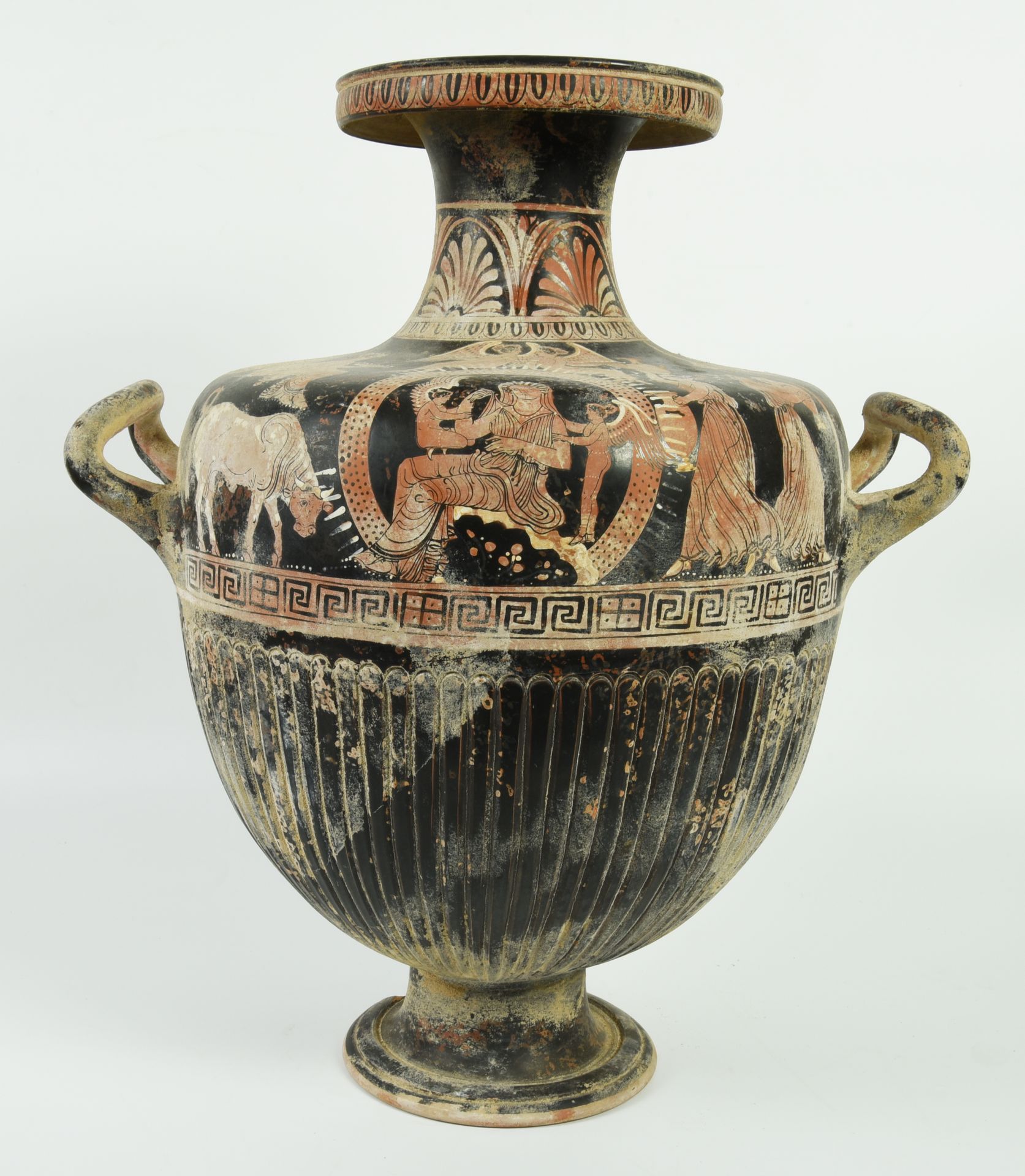Description
HYDRIA APULA WITH RED FIGURES DATE: 350-330 BC. MATERIAL AND TECHNIQUE: pinkish figulina clay, shiny black paint, white overpainting, modelled by fast lathe. Flattened brim with oblique lip pendulum, high cylindrical neck with concave profile, distinct from the shoulder flattened, ovoid body tapered below and baccellato, high foot bell, rear loop stick, set from the neck to the shoulder, lateral loops stick twisted upward and set obliquely on the belly. ADDITIONAL DECORATION: lip spared; rim with ionic kyma; on the neck a theory of palmettes open like a fan, at the base of the neck ionic kyma; under the figurative scene right-hand meander interrupted by a chessboard motif; inside of the handles spared, under the back handle large palmette open like a fan between whirls and volutes that go up again also on the shoulder forming further palmettes. DECORATION: at the center, within a cave schematically indicated is a female figure seated to the right on a boulder, with veil on the head, stephane radiata, earrings, string of pearls, armillas on the wrists and a long pleated dress stopped at the waist by a belt and shoulders by two circular fibulae. The woman is cared for by two naked but bejeweled androgynous heroes wearing shoes. Above the vault of the cave two other heroes seated and opposed, retrospective are in conversation. On the left side of the cave above a young woman, elegantly dressed, seated on the left, holds a phiale baccellata in his left hand, while at the bottom of a bull facing left grazes with his head down. On the right side instead two handmaidens are in the act of drawing water with the hydria from a fountain mascherone placed at the top. PRODUCTION: Apulian pottery with red figures, workshop of the Painter of Bari. STATE OF CONSERVATION: intact except for a gap on the foot DIMENSIONS: h. cm 48,5, diam. mouth cm 17,5 ORIGIN: private collection, Bari CFR.: A. D. Trendall, A. Cambitoglou The red-figured Vase of Apulia II, Oxford 1982 The lot, according to Italian law, is not exportable / This lot, according to Italian law, can not be exported
259
HYDRIA APULA WITH RED FIGURES DATE: 350-330 BC. MATERIAL AND TECHNIQUE: pinkish figulina clay, shiny black paint, white overpainting, modelled by fast lathe. Flattened brim with oblique lip pendulum, high cylindrical neck with concave profile, distinct from the shoulder flattened, ovoid body tapered below and baccellato, high foot bell, rear loop stick, set from the neck to the shoulder, lateral loops stick twisted upward and set obliquely on the belly. ADDITIONAL DECORATION: lip spared; rim with ionic kyma; on the neck a theory of palmettes open like a fan, at the base of the neck ionic kyma; under the figurative scene right-hand meander interrupted by a chessboard motif; inside of the handles spared, under the back handle large palmette open like a fan between whirls and volutes that go up again also on the shoulder forming further palmettes. DECORATION: at the center, within a cave schematically indicated is a female figure seated to the right on a boulder, with veil on the head, stephane radiata, earrings, string of pearls, armillas on the wrists and a long pleated dress stopped at the waist by a belt and shoulders by two circular fibulae. The woman is cared for by two naked but bejeweled androgynous heroes wearing shoes. Above the vault of the cave two other heroes seated and opposed, retrospective are in conversation. On the left side of the cave above a young woman, elegantly dressed, seated on the left, holds a phiale baccellata in his left hand, while at the bottom of a bull facing left grazes with his head down. On the right side instead two handmaidens are in the act of drawing water with the hydria from a fountain mascherone placed at the top. PRODUCTION: Apulian pottery with red figures, workshop of the Painter of Bari. STATE OF CONSERVATION: intact except for a gap on the foot DIMENSIONS: h. cm 48,5, diam. mouth cm 17,5 ORIGIN: private collection, Bari CFR.: A. D. Trendall, A. Cambitoglou The red-figured Vase of Apulia II, Oxford 1982 The lot, according to Italian law, is not exportable / This lot, according to Italian law, can not be exported
You may also like
